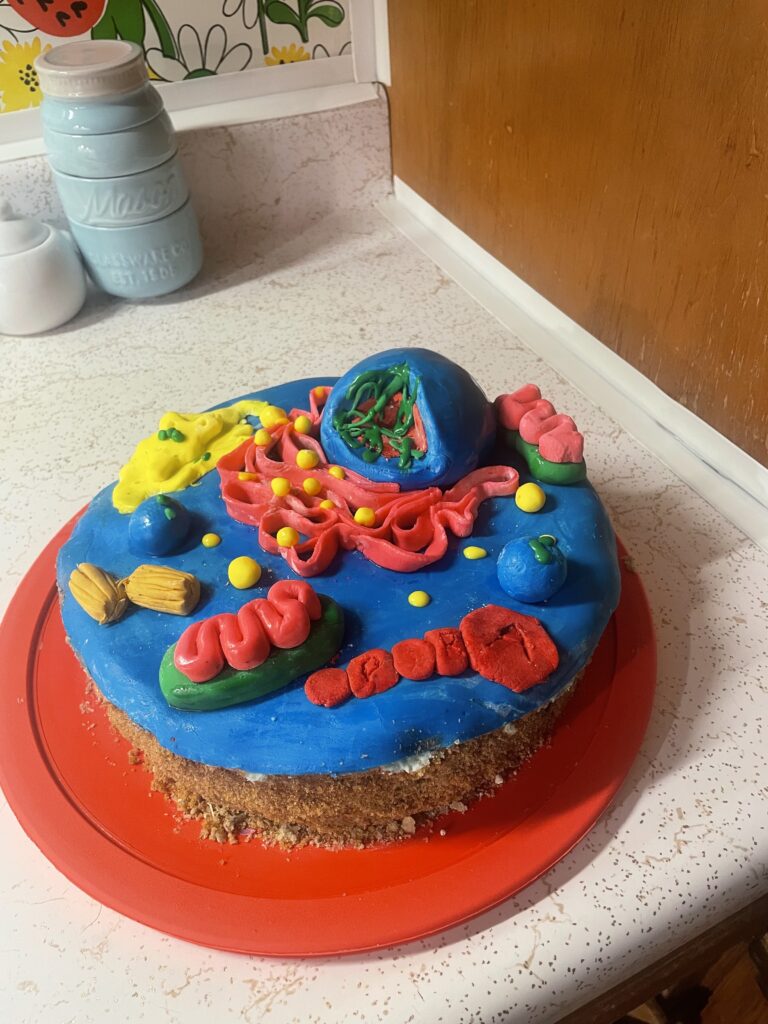
The objectives from the course that I connected my project to are: to “Identify Nucleic Acids, Lipids, Carbohydrates and Proteins”, and “Compare and Contrast the different organic molecules” as well as to “know the different energy molecules in the cell and their use in anaerobic and aerobic exercise”.
For my project I made a cake. I begin my project with a video labeling the ingredients used in making a cake, and identifying the type of organic molecule by naming the structure. In this video I combine these ingredients in order to bake a cake. I decorated this cake to be a model of the human cell.
I was able to represent the objective regarding adenosine triphosphate as I found within my research a model for the molecule in a peer reviewed article by Jerry Bergman. I was able to place this molecule representation near the mitochondria I modeled as the mitochondria is where ATP is produced by ”Charging ADP to form ATP in the mitochondria is called chemiosmotic phosphorylation. This process occurs in specially constructed chambers located in the mitochondrion’s inner membranes” (ATP Bergman 2002).
In my project I also represented the objectives regarding organic molecules as I was able to identify them in my project video. By identifying the chemical compound, and identifying which group the ingredient associates with, I am able to deepen the understanding of this concept. These organic molecules we learned about are things we consume in our everyday diet. To see these compounds come together to become a cake is a representation of the makeup of our bodies. In this video of making the cake I have real examples of each organic compound. The cake is made of a Carbohydrates in the flour, and sugar used. There are examples of nucleic acids in the vanilla extract as well as sodium bicarbonate. There were many examples of Lipids in vegetable oil, butter, and buttermilk. There were even protein examples with the cocoa and eggs used.
In my cake I tried to accurately represent the organelles we learned about. I made blue frosting to represent the cytoplasm and covered the outside of the cake with brown sugar to represent the cell membrane. I included the nucleus, the cells control center containing a nuclear envelope and a nucleolus. I represented chromatin and condensed chromosomes to show the potential of the DNA material preparing for mitosis. I represented ribosomes the “molecular factories that make proteins” attached to the rough endoplasmic reticulum.I also included the smooth endoplasmic reticulum. I represented lysosomes within the cell, breaking down waste. I made a golgi body with proteins inside. I also made the mitochondria, the “power plant” of the cell that converts food energy into ATP which I included with a representation of the ATP molecule
(US Department of Health).
I really enjoyed this opportunity to apply my knowledge to an artistic project. I hope my application of the material can help others to understand as it helped me.
Works Cited
ATP: The perfect energy currency for the cell – the apologia project. (n.d.). Retrieved November 23, 2022, from https://theapologiaproject.com/PDFs/science/ATP.pdf
Barišić, V., Kopjar, M., Jozinović, A., Flanjak, I., Ačkar, Đ., Miličević, B., Šubarić, D., Jokić, S., & Babić, J. (2019, August 30). The chemistry behind Chocolate production. Molecules (Basel, Switzerland). Retrieved November 22, 2022, from https://www.ncbi.nlm.nih.gov/pmc/articles/PMC6749277/
Chemical and physical properties. About the Caffeine Molecule. (n.d.). Retrieved November 22, 2022, from https://www.scienceofcooking.com/caffeine.htm
nucleusanimation. (2015, March 18). Biology: Cell structure I nucleus medical media. YouTube. Retrieved November 22, 2022, from https://www.youtube.com/watch?v=URUJD5NEXC8&t=7s
U.S. Department of Health and Human Services. (n.d.). Studying cells. National Institute of General Medical Sciences. Retrieved November 22, 2022, from https://nigms.nih.gov/education/fact-sheets/Pages/studying-cells.aspx
U.S. National Library of Medicine. (n.d.). Coffee extract. National Center for Biotechnology Information. PubChem Compound Database. Retrieved November 22, 2022, from https://pubchem.ncbi.nlm.nih.gov/compound/Coffee-extract

Chloe Sears takes on three objectives from the course in this STEAM project. The three objectives are: “Identify Nucleic Acids, Lipids, Carbohydrates and Proteins”, “Compare and Contrast the different organic molecules”, and “know the different energy molecules in the cell and their use in anaerobic and aerobic exercise.” Chloe demonstrates these three objectives through a written text, a baked cake representing a human cell, and through a video showing the ingredients of the cake and the process of making the cake. Each component of the cake represents a component of the human cell as outlined in both her video and written essay. One main point Chloe makes in her written essay is that she can see how the different parts of the human cell come together as she sees the ingredients of her cake come together. The video that Chloe posted on the page itself didn’t work but the link provided did. Of the six sources listed in the works cited section, only two of them appear to be cited in the text itself. Overall, it was a creative way to show how each part of the human cell is as distinct as the different parts of a cake. And it showed just how each part comes together to make something that’s greater than just the sum of its parts.